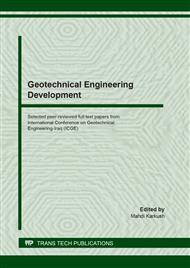p.349
p.358
p.367
p.374
p.383
p.394
p.399
p.409
p.417
Estimation of Bearing Capacity Dropping Due to Cavities from Gypseous Soils Melting
Abstract:
The presence of gypsum in the soil will cause problems if the source of freshwater is available and permeable soil permitting significant movement of water is to take place. The solubility of gypsum by excess water from irrigation or localized leak into the gypseous soil may cause cavity formation. In this research, a model was developed for governing the mass-transport to assess the variation of gypsum content of the soil during dissolution. A general three-dimensional finite element program (PLAXIS tunnel) was selected for the numerical analysis method to generate the solution. Parameters that affect the bearing capacity of a square footing represented by the gypsum content, the cavity volume, and the location of the cavity which represent by three offset distances from the footing center to the cavity center (x, y, and z), where (X) represents the horizontal distance, (Y) represents the vertical (depth) distance, and (Z) represents the diagonal distance. The main results show that the cavity location found to be the most parameter that affects the bearing capacity ratio (BCR). The minimum values are found when the cavity locates at the center of the footing base, and the lowest one (0.211) when the gypsum dissolved equal to 40%, also there is no effect of the cavity location when the ratio of (X/B) and (Z/B) exceed (3.0) for any depth and when the gypsum dissolved less than 10%. For high gypsum dissolution (more than 30%), the dimensionless ratios (X/B), (Z/B), and (Y/B) of the cavity must be more than 5.0.
Info:
Periodical:
Pages:
409-416
Citation:
Online since:
August 2020
Authors:
Keywords:
Price:
Сopyright:
© 2020 Trans Tech Publications Ltd. All Rights Reserved
Share:
Citation:


